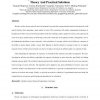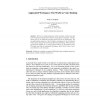HCI
2009
14 years 4 days ago
2009
A mirror world, which is a virtual space modeling a physical space, attracts enormous interests from VR community recently. Various applications such as Second Life, Google Earth a...
WINET
2002
14 years 2 months ago
2002
Wireless ad-hoc sensor networks have the potential to provide the missing interface between the physical world and the Internet, thus impacting a large number of users. This conne...
AC
2002
Springer
14 years 2 months ago
2002
Springer
nce of computation has systematically abstracted away the physical world. Embedded software systems, however, engage the physical world. Time, concurrency, liveness, robustness, c...
LOGCOM
2008
14 years 2 months ago
2008
We consider continuous quantities that are used to describe the physical world, such as colour, shape, sound, texture, and spatial and temporal arrangements. Natural languages are...
BIRTHDAY
2007
Springer
14 years 6 months ago
2007
Springer
Well understood methods exist for developing programs from formal specifications. Not only do such methods offer a precise check that certain sorts of deviations from their specifi...
ICWE
2010
Springer
14 years 6 months ago
2010
Springer
Future Web applications will increasingly require real-time data from the physical world collected by a myriad of sensors and actuators. Currently, integration of such devices requ...
HUC
1999
Springer
14 years 6 months ago
1999
Springer
We live in a three dimensional world, and much of what we do and how we interact in the physical world has a strong spatial component. Unfortunately, most of our interaction with t...
HUC
2005
Springer
14 years 8 months ago
2005
Springer
A frameless display is a display with no perceptible boundaries; it appears to be embodied in the physical world. Frameless displays are created by projecting visual elements on a ...
SAC
2005
ACM
14 years 8 months ago
2005
ACM
In ubiquitous computing era, the notion of context-awareness will play an important role. An application should be aware of its operating context for supporting and enriching huma...
ACMACE
2005
ACM
14 years 8 months ago
2005
ACM
There have been a number of interactive games created for Augmented Reality (AR) environments. In this paper, interaction techniques to support Real-Time Strategy (RTS) games in A...




